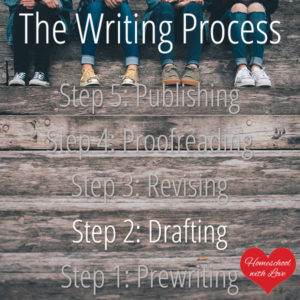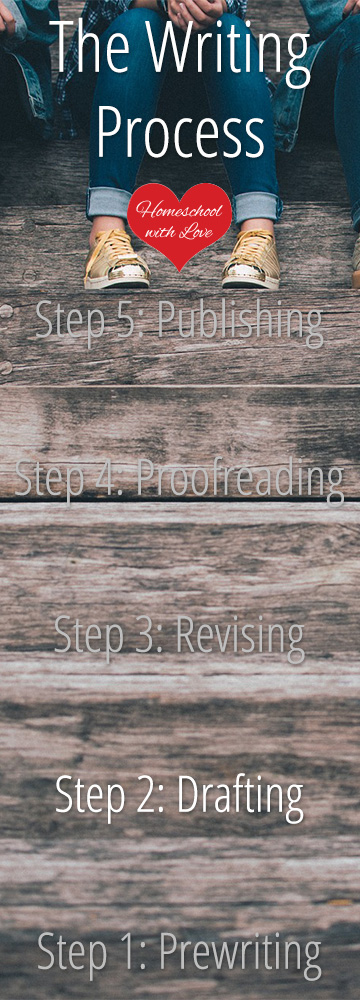
Step 2 of the writing process is Drafting.
Here is where your child writes her first rough draft or “sloppy copy”.
It’s important that she not be overly concerned about the paper being perfect. Improvements will be made on the paper later.
Here’s what she should know about writing her draft.
The Writing Process Step 2: Drafting
Writing the Draft
Now your child gets to start writing about what he learned. At this point, you might want to introduce him to the fancy word, “plagiarism”. Explain to him what it means (stealing someone’s words) and how to avoid it (quoting someone or using your own words).
Three Parts of a Paper
The three main parts of any paper are the Introduction, Body, and Conclusion. Here is a general idea of what they should look like.
Introduction
This usually starts with a “hook” of some kind. That’s a sentence about the topic that grabs the reader’s attention. It can be fun fact, a thought-provoking question, or an exciting statement.
The hook is usually followed by the “thesis” statement. This is another one of those fancy words. The dictionary describes it as “a subject for a composition or essay”. So a thesis statement is a sentence which tells what the paper is about. It can be more than one sentence sometimes.
Then your child can write another sentence or two (or more if he’s really good) to get the reader ready for the rest of the paper. This can be sentences telling a little about the main points that will be covered in the paper.
Finally, your child can conclude the introduction with a sentence that leads into the next paragraph. This is called a transition.
*Special Note: Younger children may struggle with some parts of the introduction like the transition. That’s fine. What is most important for them is that they have a topic sentence telling what their paper is going to be about and then a few more sentences to get the reader ready. When teaching children how to write papers, you want to start simple. Then add some of the more elaborate stuff like transitions as they get older.
Body
This is the main part of the paper. Here your child can use her outline/map from Step 1 as a guide. She will write a paragraph for each of her main points. Each paragraph should start with a topic sentence. Then more sentences follow with supporting details.
Older writers should learn to use transition words and phrases. These include first, next, then, additionally, therefore, besides, in addition to, before, after, and though. You can find a whole bunch of transition words here.
Conclusion
The conclusion is where your child summarizes in a few sentences what he discussed in the paper. He should restate his topic sentence in a different way as well.
Writing on Paper vs. Typing
Is your child writing her draft on notebook paper? Then you will want to take these things into consideration. She will have to write it in order. She should probably skip lines so that she has more room for editing later. She’ll have to recopy her paper or type it when she is ready to do the final draft.
Typing with a word processing program is much easier. If she does this, she will not have to type her paper in order. She can choose a random paragraph to start with. I know this seems odd, but I went to an author’s webinar this summer and one of the speaker’s, Dan Poynter, said that he starts with the section that is most appealing to him. Then he does the next most appealing and so on. That is how he stays motivated to write. Thanks to computers and outlines/maps, every paragraph can be placed in its proper order. Then Dan also said that he does the intro and conclusion last. Just some things you might want to consider trying out with your kids. I recommended it to my teens.
Typing should be double-spaced. Usually a 12 pt font is used. Times New Roman is a common font, but some like Arial or something else. That is up to you and your child. Remind your child to save frequently so that he doesn’t lose much of his work if the computer crashes.
Regardless of whether your child writes or types, what is most important is that he gets his ideas down. He shouldn’t be concerned with spelling or grammar too much at this point. It’s also fine if his wording isn’t exactly what he wants. He’ll have the opportunity to revise and proofread in Steps 3 and 4.
This step should take a few days to complete, but that depends on the length of the paper.
On to Step 3.







